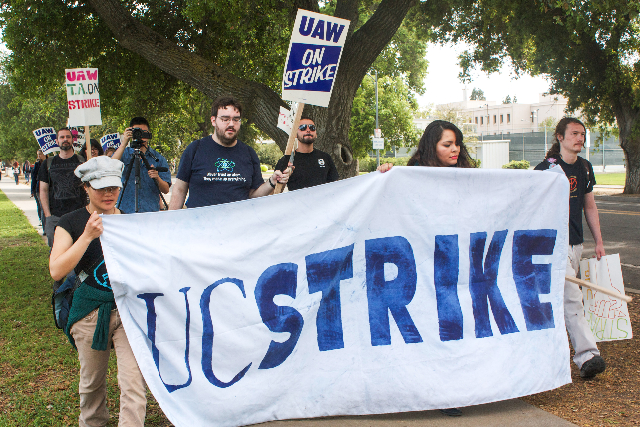Dissatisfied, UC Davis teaching assistants (TAs) congregated near the corner of Russell Boulevard and Howard Way on April 3 to protest ongoing labor practices that the University of California (UC) system has yet to address.
Since June 2013, the members of the UC Student Workers Union (UAW 2865) have been bargaining with the UC over topics including, but not limited to, various intimidation tactics used by the University, larger classroom sizes and the limited number of quarters a graduate student is allowed to work as a TA.
“We struck in order to tell the University that they should not commit unfair labor practices, specifically when dealing with the unions,” said UAW 2865 UC Davis current unit chair Marco Rosales. “The University has been committing a few illegal practices such as intimidation, and we’re trying to express to the University that we’re not going to take that anymore.”
The strike took place on several UC campuses, and according to Rosales, various intimidation practices were used against the protestors during the strikes themselves, like filming, stating that the strike was illegal, arresting protesters at the Santa Cruz campus and threatening to take visas away from international students.
“That was one of the reasons why we went on strike,” Rosales said in response to the threat regarding international student visas. “That was a pretty plain form of intimidation that’s completely unethical.”
The issue of classroom size not only affects graduate students, but undergraduates as well.
“It’s about pedagogic authority,” said UAW 2865 UC Davis former unit chair Duane Wright. “When they are increasing class sizes that makes it so that the options of what we can do in the classroom become fewer and fewer. We can’t do as much interactive teaching. Even though we’re supposed to be these highly skilled workers, they’re limiting how we can exercise our pedagogical authority.”
According to Wright, most graduate students agree that class size has a lot to do with the quality of education. Depending on the department, class sizes can range from a somewhat manageable size of about 50 students to a considerably larger amount exceeding 100.
“What happens with larger classroom sizes is, we’re forced to make choices,” said second-year Ph.D. student in history Nathalie Collin. “Either we work ourselves into the ground and put in way more hours than we’re supposed to, which then affects our own work that’s supposed to be completed at a certain time, or we neglect the quality of the education that we’re giving our undergraduate students by [writing] ‘Nice Job, A’ on a paper, instead of giving detailed feedback.”
Fourth-year Ph.D. student in geography Bidita Tithi finds the larger classroom sizes to be especially difficult when grappling between the time she devotes to her students versus the time she devotes to her research.
“Now we have larger sections with more students, and that puts stress on the TAs’ jobs because we have to hold longer office hours,” Tithi said. “If we hold office hours for only one hour, then the students may be deprived. At the same time it’s more grating, it’s more time devoted to connecting with students. It creates a lot of stress.”
Another important issue for many graduate students is the limited funding the University provides.
“My research involves going to another country, I research Argentina,” Collin said. “I’m not going to get a Ph.D. in five years, it’s impossible. Depending on what you’re studying, it’s no surprise to take six, seven, eight, nine years. The University has this expectation of using us as labor essentially for however many quarters and if we don’t do everything plus the work they want us to do, we’re out. It’s a very tough position for us to be in.”
The University stops funding students after 18 quarters of work. If they are not finished with their research in the six years that are allotted, then they must find another way of funding their studies.
“I am an international student — I cannot legally work outside of UC Davis,” Tithi said. “This is basically the only way that I can fund my education and feed myself. So for me, that’s very problematic — there’s this limited number of quarters that I can work and it creates lot of stress.”
The time commitment requirement was another significant part of the protest. TAs usually have around a 20-hour per week commitment. However, this is not always the case with increasing class sizes and responsibilities.
“Three hours for lecture, two hours for section, two-hour office hours — that’s already seven hours out of the 20 that are burnt up on specific required tasks,” Collin said. “The other time in the week you have to spend doing the reading (which take a while) and then the assignments and grading vary. So that’s an issue — there’s no consistency for us.”
Recently, the UC Student Workers Union won two landmark decisions: safe bathroom access for people of all genders, including those who fall outside of the gender binary, and guaranteed lactation stations for graduate workers with children. Apart from these developments, there have not been any apparent decisions made on other issues.
“Every undergraduate that I’ve spoken to about this has been very supportive once they hear what’s going on,” Collin said. “I think it’s important for people to know the whole story. One of the big concerns of the graduate students is how this is also affecting [the undergrads], because most of us don’t feel we can give you the education that you are paying for — and that is a very big issue.”
ELLIE DIERKING can be reached at features@theaggie.org.
Photo by Misha Velasquez.







